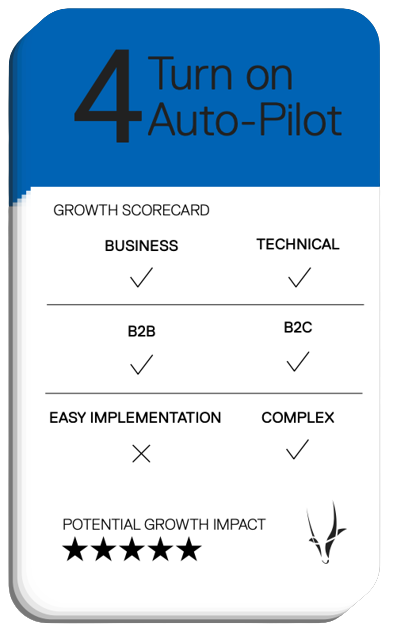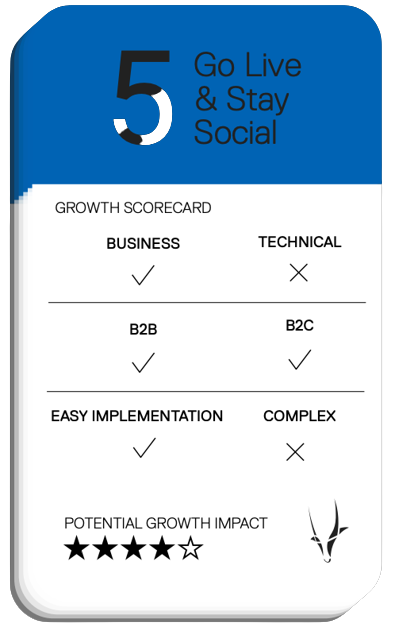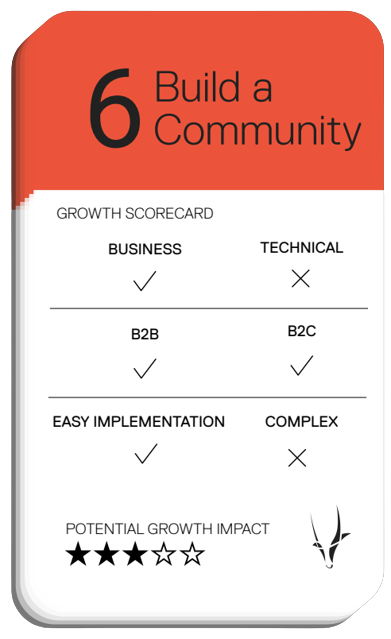6 Retail E-commerce Strategies to Increase your Bottom Line
An e-commerce growth plan that will boost your business performanceThe Status Quo of E-Commerce Growth
What does it take for a magician to be successful on stage? The right deck of cards (on top of some talent, of course). This is also what retailers need nowadays to navigate the variables of an ever-evolving industry: the right winning strategies at the right time. With the booming e-commerce market on the rise, retailers have the chance to innovate and adopt new plans to grow and prosper. In this white paper, we outline 6 e-commerce strategies that will help your retail business scale for success. Play your cards right and learn all the tricks of the trade!How exactly is e-commerce booming, and how important is it for retail? Let us count the ways:
- Retail e-commerce sales are predicted to grow double-digits. Emarketer projects that worldwide e-commerce sales will total $6.169 trillion and make up 22.3% market share of total retail sales.
- Nasdaq predicts that by 2040, 95% of purchases will be facilitated by e-commerce in the UK.
- China accounts for 52.1% of all retail e-commerce sales worldwide with its nearly $3 trillion e-commerce market, according to Emarketer.
These numbers highlight that e-commerce is indeed booming, and that it’s happening on a global playing field.
In this white paper, we cover 6 growth strategies that will help your business innovate, penetrate new markets, test and adopt new business models, and ultimately, leverage available and ever-evolving e-commerce technologies.
Marketplace Mastery
Marketplace sales currently account for 67% of the global online retail sales. In 2021 alone, about $3.23 trillion was spent on the world’s top 100 marketplaces. Mastering a marketplace is a proven way of effectively scaling an e-commerce business, so if it’s not part of your growth strategy, pay attention
What do we mean by a marketplace?
A marketplace is a platform where sellers and buyers join forces to buy and sell products. Amazon was one of the original marketplace platforms, and continues to dominate the space today – but don’t let that put you off. There is still plenty of room to make a profit in the platform economy, especially for niche businesses in both the B2B and B2C sectors.
Gartner predicts that 15% of medium-to high-gross-merchandise-value digital commerce organizations will have deployed their marketplaces, thereby creating an entirely new digital ecosystem – and your business could be one of them. For businesses with an existing traditional e-commerce platform, a digital marketplace could be the next growth step towards accelerating customer acquisition and increasing revenue.
Starting a marketplace for growth
One major advantage of the marketplace model is that you can offer your customers a much larger product offering, without taking on the inventory risk – a win-win for all stakeholders involved. A broad product portfolio and higher inventory levels equate to easier discovery by customers, which in turn leads to sales.
Many B2B and B2C businesses worry about the competitive nature of enterprise marketplaces. However, they fail to consider the benefits they could lose out on if they disregard a marketplace as a future growth opportunity.
Quickfire benefits of a marketplace
- Effortless scale: increase product assortment at a low cost
- Increased profit margins: new revenue streams and commission on sales equal increased profit
- Diversify your offerings: test and adapt products with new merchants based on customer behavior
- Improve SEO and increase traffic: More merchants and more products equal more website traffic
- Go 24/7: Local merchants in different time zones facilitate internationalization and a 24/7 business.
- Work with merchants on strategy: Rely on your merchants’ expertise so you can focus on which strategies result in the highest profit.
- Foster customer loyalty: Become the one-stop-shop for your customers with a broad offering, increasing retention.
- Ownership: Control which merchants you work with and what permissions they have.
Get a Head(less) Start
Forbes said it best: “Aristotle said the human body is at its best at age 30. The same can now be said for e-commerce, which turned 30 this year. The best way to celebrate this milestone is with a new headless architecture.”
But what exactly does ‘go headless’ mean?
In essence, headless means a front and back-end which function independently and are ‘de-coupled’. This allows companies to be more agile and adaptable, and tailor their front-end with evolving customer demands. Most traditional e-commerce systems are monolithic, where the front and backend systems are inextricably linked, and have very little room for flexibility. This is a challenge for businesses that want a more personalized and flexible user experience.
Going headless means it’s easier to connect various sales channels such as mobile, social, wearables, voice assistants, and more. We discuss some of these newer revenue streams in detail later on, but for now, just understand that a headless architecture is a crucial growth strategy if your business goals include quickly adapting to evolving market and customer demands.
Quickfire benefits of Headless
- Flexibility: Customize your storefront(s) however you like without impacting the back-end.
- Customization & Personalization: Create custom user experiences and refine them along the way.
- Time to Market: Easier expansion and integration result in faster implementation, i.e. a much shorter time frame to release a new market-ready product.
- Omnichannel experience: Multiple touchpoints facilitate a seamless customer journey
Globalize your Brand
Borders are becoming increasingly meaningless when it comes to e-commerce. For example, a customer sitting in Europe can order an item from China, or vice versa, and pick the best deal from multiple international sellers. While this creates increased competition (especially with low manufacturing costs in developing countries), it also opens up the possibility for a much larger customer base.
80% of retailers worldwide agree that cross-border trade is profitable. Forrester predicted that cross-border purchases made up 20% of all e-commerce trade by 2022, illustrating that internationalization is a hot ticket on the agenda for many businesses. So, if you’ve got a viable business model in your home market, you should consider expanding to new countries as part of your growth strategy.
Of course, it’s important to consider how the market might be different in another country, but internationalization remains a key and very important strategy for success. When choosing an e-commerce software provider, opt for one with a multi-store capability. This allows you to create a single store with one product database that can serve multiple regions or languages, or separate regional stores with localized product offerings.
43% of sellers report that managing customers’ delivery expectations is a big issue when going international, so it’s important to consider your logistics infrastructure before launching any large internationalization projects.
Consider internationalizing through an enterprise marketplace. It’s an effective way to test your products in different markets without a huge investment, before fully going to market.
Expanding your brand offerings could be also part of your 2022 growth strategy. Enterprises should consider brand expansion for a number of reasons, such as target new customer bases or taking advantage of niche offerings.
Similarly to internationalization, it’s important to work with an e-commerce system that utilizes multi-store features. This helps you to easily manage multiple storefronts with distinct brand positioning from the same core product assortment. You can then customize these separate storefronts depending on your customer or market needs. For example, provide specialized discounts, or enable a completely different store logic and navigation experience.

Quickfire benefits of internationalization
- Lower & more predictable costs: More cost-effective than fully launching into a new market with no previous knowledge.
- Increased reach: Tapping into your merchant’s customer base, means lower customer acquisition costs for you
- Test new markets easily: Dip into desired new markets before committing to a full go-to market plan.
- Fast feedback: Gather data and insights from customer behavior with a test and learn mentality.
- Low entry barrier: Easy technical implementation means lower IT investment at the MVP stage.

Turn on Auto-Pilot
Automation is not only changing the face of e-commerce, but the entire world we live in. In a not-so-distant future where empty fridges automatically order missing grocery items, cars drive themselves, and store clerks are replaced by AI, it’s important to consider how technological advances will impact e-commerce in the retail industry.
In a recent forecast, Gartner predicted that e-commerce platforms using AI will achieve an improvement of at least 25% in customer satisfaction, with increased revenues and cost reductions. Globally...
... AI’s market value is predicted to reach $126 billion by 2025.
Retailers can turn to automation in order to streamline processes in retail stores, warehouses, or distribution centers. According to recent estimates, the global retail automation market is forecast to grow to $33 billion U.S. dollars by 2030.
Why is automation so important for the retail industry? Simply put, it will save your business time and money. A higher level of automation equals lower overhead, increased efficiency, and lower production and logistics costs.
Quickfire benefits of Automation
- Increased accuracy: With automation, human errors are less likely to happen and data about inventory levels and order fulfilments is more accurate. Businesses utilizing automated solutions in their warehouses record double-digit improvements due to overall increased efficiency and productivity.
- Happy workforce and reduced labor costs: Automation streamlines and replaces manual, repetitive and lowvalue processes. This can ease up the retail employees’ workload and allow them to concentrate on more valuable tasks, such as customer service and creative problemsolving. A game changer for the Great Resignation.
- AI customer service: Intelligent chat-bots mean round-the-clock customer service. Important, considering that 90% of customers prefer to shop where companies are able to answer inquiries immediately, and 48% of consumers prefer live chat over any other method of contact.
- Personalization: Reports show that 10-30% of all e-commerce purchases are due to recommendations. AI helps to generate product recommendations, not only using purchase history data, but also insights from similar customers’ buying behavior. Customers say they are more than twice as likely to add items to the basket and 40% more likely to spend more than planned when experiences are highly personalized.
- Diverse touchpoints: Voice shopping, wearables, VR - new technology is being developed all the time which both utilize AI and increase the potential customer touchpoints available. Voice shopping alone is set to reach $40 billion by 2022, illustrating the demand and growth potential.
Go Live & Stay Social
While some business models were decimated due to the pandemic, others have soared above and beyond expectations. One such industry is social media. There are now more than 4.5 billion social media users around the world, growing almost 10% in a year, and TikTok just hit the 1 billion user milestone. Billions of users equal billions of potential customers, so it’s no surprise that social commerce is growing into a giant industry – and a key growth strategy for e-commerce and beyond.
Shopping on social media is expected to triple by 2025, growing from $492 billion in 2021 to $1.2 trillion by 2025. Whether it’s via Instagram, Facebook, Snapchat, TikTok, Whatsapp, Wechat, or more, social media platforms are generating new ways to reach customers every day, and analysts predict that it’s going to account for a huge chunk of e-commerce sales in the future
One exciting revenue stream opportunity within the social space is live shopping. China is leading the way, with two-thirds of Chinese consumers reporting that they had bought products via lifestream in the last year. Meanwhile, 2020’s Single’s Day presales campaign on Taobao Live generated $7.5 billion for Alibaba in the first 30 minutes alone. McKinsey predicts that if we take China as the leading example, live shopping sales could account for as much as 10-20% of all e-commerce by 2026.
A reported 70% of Europeans are open to live shopping, however, it’s still a relatively small market compared to China, which means that there is a huge opportunity for businesses willing to invest in this growth strategy.
What exactly is social commerce? Social commerce is the method of promoting and selling goods or services directly via social networking platforms. It includes practices such as offering promotions, creating viral video content, recommendations or endorsements via influencers.
What exactly is live shopping? Live shopping combines the sale of a featured product with instant audience participation through chat or reaction functionality through internet livestreaming.

Quickfire benefits of Social commerce
- Customer engagement: Interacting directly with your customers via social media builds trust, awareness, and authenticity of your brand.
- Accelerated audience growth & conversion: McKinsey reports that companies report conversion rates in social commerce as approaching 30 percent—up to ten times higher than in conventional e-commerce. Limited time promotions generate a sense of urgency in buyers, pushing them quickly through the funnel from awareness to purchase.
- Brand appeal: Something like live shopping illustrates differentiation in a saturated market, and shows customers that you’re brave enough to try something new.
- Customer insights: Most social platforms have in-built analytics tools measuring impressions and reach, garnering more data about your customer base which can be used to improve personalization and targeting.
- Higher order values: By making shopping quick and easy where a buyer can view something they like on social media and immediately purchase it, cart values increase.
- Improved SEO: Social commerce accelerates organic traffic to your website as you target users with relevant content, which in turn improves your digital rankings.

Build a Community
Building on the idea of social commerce, consider community building as a potential growth strategy for your business in 2022. How does building a community help your business to scale? Nielsen reports that 92% of global consumers trust recommendations from friends and family above other forms of advertising. As such, community building can lead to increased customer acquisition and retention, as community members interact, share reviews, and offer instant feedback.
There are a couple of core ideas that are essential for successful community building:
- understand your audience
- provide value with the content you offer, and
- engage and inspire organic growth with human interaction.
Quickfire benefits of a Community
- Low cost: It can be extremely cost-efficient to start building a community. A social platform such as Facebook is free. Do your research about what forums your target audience uses and start communicating with them there - for free.
- Feedback: Communities offer instant and free feedback. This means that you can test products, ideas, and messaging on your loyal community before rolling it out to your larger customer base.
- Brand: Consumers love a brand with personality, where it’s clear that real humans work there. Think about some of the most popular Twitter accounts, such as Wendy’s with nearly 4 million followers. When customers reach out and receive a human response, they feel more connected to the brand
- Site traffic: Engaged community members who interact with your content will be more likely to visit your e-commerce site and make a purchase.
Conclusion
Every business aspires to growth – that’s what keeps the engine and the motivation running. To be able to efficiently and consistently improve, businesses need to challenge the status quo and open their doors to change.
As industries evolve rapidly due to technological innovation, unpredictable disruptions and shifting customers’ values, as a retailer you should wisely choose the most successful cards to play: the right strategies will put your business in pole position.
Whichever growth strategy you’re considering, Spryker and our extensive network of solution and technology partners can help your business to never miss a trick and make an awe-striking performance – voila!
Interested?
Spryker has already conducted studies on the status quo and the potential of online grocery in three countries (US, UK, Germany). Learn about consumer behavior, brand recognition, and the role of technology, and how those differ between regions. Read the latest insights on online grocery and e-food: Read nowAbout Spryker
Spryker is the leading global composable commerce platform for enterprises with sophisticated business models to enable growth, innovation, and differentiation. Designed specifically for sophisticated transactional businesses, Spryker’s easy-to-use, headless, API-first model offers a best-of-breed approach that provides businesses the flexibility to adapt, scale, and quickly go to market while facilitating faster time-to-value throughout their digital transformation journey. As a global platform leader for B2B and B2C Enterprise Marketplaces, IoT Commerce, and Unified Commerce, Spryker has empowered 150+ global enterprise customers worldwide and is trusted by brands such as ALDI, Siemens, ZF Friedrichshafen, and Ricoh. Spryker is a privately held technology company headquartered in Berlin and New York backed by world class investors such as TCV, One Peak, Project A, Cherry Ventures, and Maverick Capital. Learn more at spryker.com.